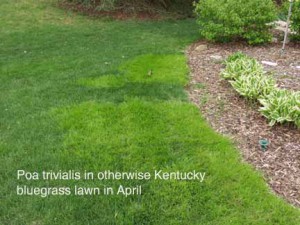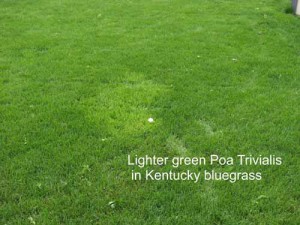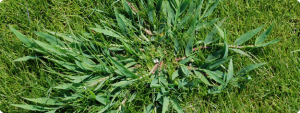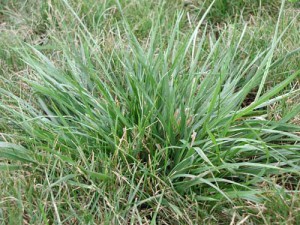Annual and Rough Bluegrass
Annual bluegrass (Poa annua) and rough bluegrass (Poa trivialis) are common grassy weeds on golf courses, but are now becoming a problem on higher mowed turf areas such as lawns and athletic fields. Both of these grasses are considered weeds because they are lighter colored than Kentucky bluegrass and perennial ryegrass. Plus they both tend to thin and die out during the heat and drought of the summer. Poa annua is especially noticeable in May and June because of it’s prolific seedhead production at mowing height. Poa trivialis, on the other hand, rarely produces a seedhead when mowed. Control of Poa annua and Poa trivialis in lawns is difficult, if not impossible. Thus it may not be economically feasible or practical to attempt control. Instead, it might be better to manage these weeds to keep them alive during the summer and blend them in with the rest of the lawn.
Poa annua
Poa annua is a winter annual that germinates in the late summer/early fall once soil temperatures fall below 70o F. Seedlings mature in the fall, spend the winter in a vegetative state, and go to seed in late spring and early summer. Annual bluegrass is a prolific seed producer. An individual plant is capable of producing more than 360 viable seeds. The seed may lie dormant in the soil for many years before germinating. Annual bluegrass flowers and produces seed over several months and at any mowing height. Poa grows well under short days and cool conditions, and it will out-compete all other turf species during late fall and early spring. Poa often dies in the heat of the summer (but may survive the stress). Since annual bluegrass favors compacted soils, aerate as often as possible to discourage it.
Biology
Poa trivialis is a perennial grass that spreads by stolons (above ground runners) forming light green patches in the turf. It is best adapted to shady, moist, or over-watered sites, and because of this, it often appears in mixtures with Kentucky bluegrass and perennial ryegrass recommended for shady areas.




Quackgrass
Quackgrass is a perennial grass that is one of the first grasses to come out of dormancy each spring and it grows a lot faster than the rest of the lawn. Quackgrass is often confused with crabgrass. Quack grass is a cool season grass, so there are no products that can selectively kill it. Quackgrass can be masked in the summer by mowing more frequently so that it does not have time to grow faster than the rest of the lawn. Regular fertilizer and sprinkling also help mask it.
Crabgrass
Crabgrass is a summer annual grass. Crabgrass germinates when soil temperatures are above 55 degrees at a 1″ depth for 3 straight days. However, must crabgrass will not germinate until the soil temperature is much warmer. We usually don’t see crabgrass in lawns in Michigan before July, but it can be seen in bare spots or bark islands in June.
Tall Fescue
Tall Fescue is a perennial grass that can be both desirable and a weed, depending on the cultivar. The new turf-type tall fescue has a longer root system which makes it more drought tolerant and uses less fertilizer. The turf-type fescues also grow well in the shade. The old varieties of tall fescue are very wide bladed, coarse, grows in bunches, and grows much faster than the rest of the lawn.





